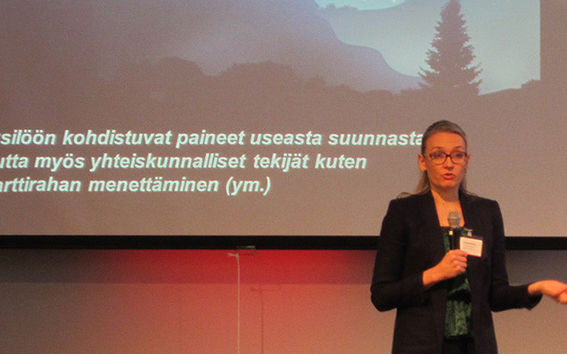Pulling out all the stops or one step at a time – hybrid entrepreneurship as an alternative

A hybrid entrepreneur is a person who simultaneously works as a paid employee and as an entrepreneur. As the complexity of working life increases, hybrid entrepreneurship has become a permanent form of entrepreneuring and an important phenomenon in society.
Charlotta Sirén, D.Sc (Econ), investigates hybrid entrepreneurship as a phenomenon and various factors that have bearing on part-time entrepreneurs moving into full-time entrepreneurship.
Bungee jumping aptly describes hybrid entrepreneurship
Hybrid entrepreneurship can be thought of as bungee jumping. In a bungee jump of this kind, a cord around the leg attaches one to paid employment: jumping means taking the risk of entrepreneurship, the cord nevertheless ensuring attachment to regular wage income. The metaphor also implies that only a few have done that bungee jump, even though there might be more interest in it. In a similar vein, although attitudes towards entrepreneurship are positive and thoughts of becoming an entrepreneur are entertained, companies are founded with much caution in Finland. According to Global Entrepreneurship Monitor (GEM), only slightly over 5% of the adult population in Finland in 2013 contemplated launching a new business activity.
Hybrid entrepreneurship has few risks and provides opportunities for self-realisation
The goal of hybrid entrepreneurs is not necessarily full-time entrepreneurship; for many, the hybrid stage is a more permanent form of employment. However, it is a good way for moving from paid employment to entrepreneurship, because it allows one to learn by experimentation and to avoid big errors. Hybrid entrepreneurship is also a less risky alternative than full-time entrepreneurship, both in an economic sense and from the perspective of one's career path. Paid employment guarantees income from wages if one's business activities turn out to be unprofitable. On the other hand, entrepreneurship can complement paid employment by bringing in extra income and providing an opportunity for self-realisation better than paid employment.
"Also employers would be well-advised to understand the phenomenon of hybrid entrepreneurship. Both parties will benefit if the ways in which the employer can promote entrepreneurship can be jointly found, and it is possible that the employer's company, too, can benefit if the employee also works as an entrepreneur. Of course, there are also challenges in hybrid entrepreneurship, including pressures due to inadequacy that an individual may encounter. A person in paid employment embarking on entrepreneurship cannot get even start money", Charlotta Sirén explains.
It is worthwhile to investigate hybrid entrepreneurship, and that is what happens
There is a rising trend in the number of hybrid entrepreneurs. In 2008 statistics of the Statistics Finland, 28% of companies were owned by hybrid entrepreneurs. Those hybrid entrepreneurs who had earlier entrepreneurial experience were not as ready to become full-time entrepreneurs as the novices in the field. According to the preliminary investigations of Sirén's research group, a great portion of the hybrid entrepreneurs are women.
Even though hybrid entrepreneurship is a form of work to be reckoned with, there are only scant amounts of practical and academic information available on the topic.
"Right now, we have a research project – Panel Study of Entrepreneurial Dynamics or PSED Finland – to be carried out over several years together with Hanken. The project follows persons who intend to become entrepreneurs. Of over 30,000 Finns, the project will identify those who plan to establish a company while remaining in paid employment. After that, the study will turn to investigate the factors which affect their path from a hybrid entrepreneur into a full-time entrepreneur. The study also will examine the role of learning and fear of failure", Charlotta Sirén clarifies further.
Charlotta Sirén, D.Sc (Econ), works as Post-Doctoral Researcher at the Department of Management Studies' Entrepreneurship unit in the Aalto University School of Business.In her research, she combines the fields of entrepreneurship and strategy research.Among other things, Charlotta's research focuses on new forms of entrepreneurship, entrepreneurial strategies and learning.She tells she has learned that entrepreneurship and an academic career are not that far from each other: in both of them, success requires the desire to continuously learn something new, creativeness, taking responsibility of one's own work and passionate devotion to the topic.Charlotta Sirén herself is also a hybrid entrepreneur, that is, she is in paid employment at Aalto University and as a shareholder in a company.
- Published:
- Updated:
Read more news

Get to know us: Associate Professor Maria Sammalkorpi
Sammalkorpi received her doctorate from Helsinki University of Technology 2004. After her defence, she has worked as a researcher at the Universities of Princeton, Yale and Aalto.
Aalto computer scientists in ICML 2024
Computer scientists in ICML 2024
Getting bacteria into line
Physicists use magnetic fields to manipulate bacterial behaviour